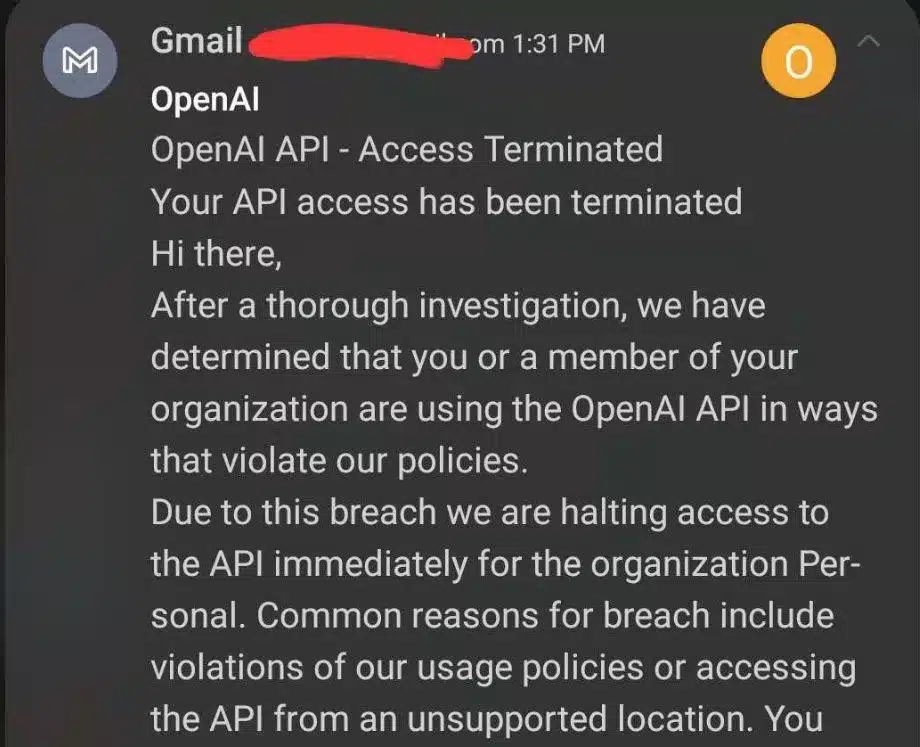OpenAI Account Suspensions: What Every Developer Needs to Know
You’ve integrated OpenAI’s API into your business model, and things are looking up. But what happens when the unexpected occurs?
What if you find your OpenAI account terminated one fine morning?
This isn’t just a scare tactic; it’s a reality that some developers have faced.
In this article, we’ll dissect OpenAI’s account termination policies, explore the role of moderation tools, and offer actionable insights to protect your business from unexpected hiccups.
By the end of this read, you’ll be armed with the knowledge to navigate this complex landscape.
The Unanticipated Email That Could Derail Your Business
Imagine this: You wake up, brew your morning coffee, and sit down to check your emails. Among them is a message from OpenAI stating that your account has been terminated.
After a thorough investigation, we have determined that you or a member of your organization are using the OpenAI API in ways that violate our policies.
Your heart sinks. You’ve always played by the rules, so what went wrong?
The lack of transparency in OpenAI’s account termination policies leaves many developers in a state of confusion and frustration.
This lack of clarity can be detrimental, especially for businesses that rely heavily on the API for their operations.
The need for more transparent guidelines is evident. Developers need to know what can trigger such drastic actions from OpenAI.
Understanding the nuances of these policies can help you take preventive measures, ensuring that you don’t find yourself in a similar situation.
User-Generated Content
User-generated content can be both a boon and a bane. On one hand, it’s what makes many applications engaging and dynamic. On the other, it’s a potential minefield of policy violations waiting to happen.
If your application allows users to input queries, you’re faced with the monumental task of ensuring those queries meet OpenAI’s guidelines.
Does OpenAI expect you to vet every user input? If so, what does that mean for your business model?
These are questions that every developer using OpenAI’s API should be asking. The implications are vast, affecting not just your application’s functionality but also its profitability.
This section aims to provide a deeper understanding of these challenges and offer strategies for managing user-generated content effectively.
The Moderation Tools at Your Disposal
OpenAI offers a suite of moderation tools aimed at helping developers filter out content that could violate their policies. The question that looms large is whether the use of these tools is optional or mandatory.
The lack of clarity around this issue can create a stressful environment for developers. You might find yourself wondering if not using these tools could be a ticking time bomb that leads to account termination.
So, what exactly do these moderation tools offer?
They provide functionalities like content filtering, keyword flagging, and risk assessment.
These features can be invaluable for developers who want to ensure that the content generated through the API aligns with OpenAI’s guidelines.
But the real challenge lies in integrating these tools seamlessly into your existing operations. It’s not just about using a tool; it’s about making it a part of your business workflow.
This involves understanding the tool’s API, setting up the necessary configurations, and continuously monitoring its performance.
Moreover, it’s crucial to keep an eye on updates and changes to OpenAI’s policies. These can affect how the moderation tools function and, consequently, your compliance with OpenAI’s terms.
By staying updated and adapting your use of moderation tools accordingly, you can mitigate the risks associated with account termination.
Safeguarding Your Business: Practical Steps
The prospect of losing months or even years of hard work due to a minor oversight is a nightmare scenario.
So, what can you do to protect yourself?
One practical step is to include unique identifiers in your API queries.
This allows you to trace back any problematic queries to the responsible user, thereby providing an extra layer of security for your OpenAI account.
But identifiers are just the starting point.
Another strategy is to implement a tiered access system for your users. For example, new users could have limited access to certain API functionalities until they’ve proven to be trustworthy.
This minimizes the risk of a new user inadvertently causing a policy violation.
Additionally, consider setting up automated alerts for specific types of content or user behaviors that could be red flags.
These alerts can be your first line of defense, giving you the opportunity to take corrective action before OpenAI flags your account.
By implementing these strategies, you’re not just safeguarding your OpenAI account; you’re also protecting your business’s reputation and integrity.
It’s a win-win situation that requires a proactive approach and a keen understanding of both OpenAI’s policies and your own operational needs.
Conclusion
Navigating OpenAI’s API landscape is like walking through a field filled with opportunities and landmines.
While the API offers immense potential for innovation and growth, it also comes with its set of challenges, one of which is the murky area of account terminations.
Until OpenAI provides more explicit guidelines, the onus falls on developers to be proactive and vigilant.
By understanding the tools and strategies at your disposal, you can take steps to ensure that your business not only survives but thrives in this complex ecosystem.
FAQs
Why should I be concerned about OpenAI’s account termination policies?
If you’re a developer using OpenAI’s API, understanding the company’s account termination policies is crucial for maintaining a stable business operation. Ignorance or misunderstanding of these policies can lead to unexpected account suspensions.
What are OpenAI’s moderation tools?
OpenAI offers a set of moderation tools designed to help developers filter out content that could violate their policies. These tools include features like content filtering, keyword flagging, and risk assessment.
Is the use of OpenAI’s moderation tools mandatory?
The article discusses the ambiguity surrounding this issue. While OpenAI provides these tools, it’s not explicitly stated whether their use is optional or mandatory for avoiding account termination.
What are some practical steps to safeguard my OpenAI account?
Some of the practical steps include using unique identifiers in your API queries, implementing a tiered access system for users, and setting up automated alerts for specific types of content or user behaviors.
How can I stay updated on changes to OpenAI’s policies?
It’s advisable to regularly check OpenAI’s official website and subscribe to their updates. This will help you stay informed about any changes to their policies, which could affect your account’s standing.
What should I do if my OpenAI account is terminated?
The first step is to reach out to OpenAI’s support to understand the reason behind the termination. Depending on the situation, you may be able to appeal the decision or take corrective actions to reinstate your account.

